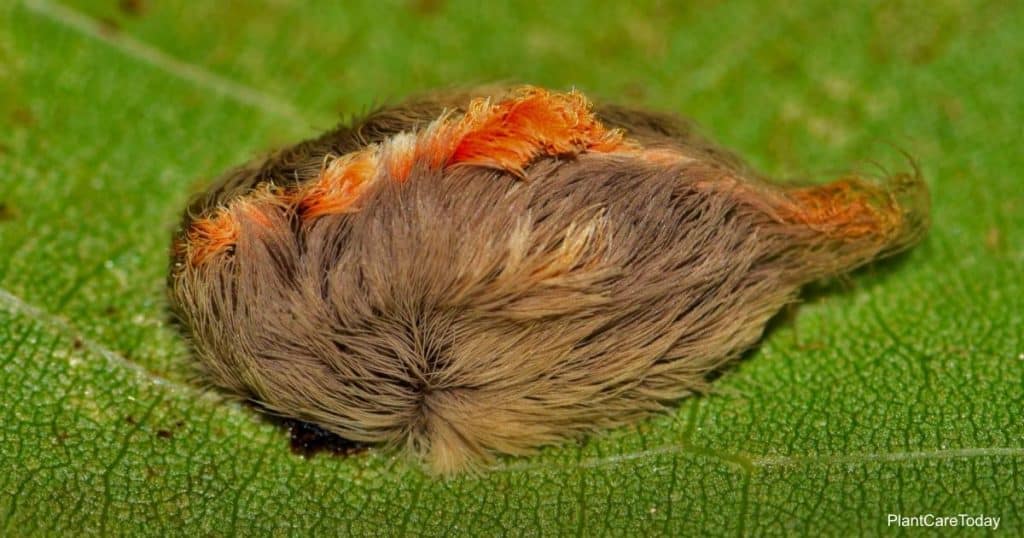Caterpillars eating leaves is a widely known fact. But, devouring leaves is not the only issue that can arise with caterpillars.

Many caterpillars, such as the Asp caterpillar, also sting and can be very harmful to both humans and other animals.
What Is The Asp Caterpillar?
The Asp caterpillar, also known as the puss moth caterpillar, the Southern Flannel Moth’s larva.
It is one of the most venomous stinging caterpillars in the United States. They are recognizable for the furry appearance that covers them completely.
This caterpillar species is prevalent on the East coast of the United States, but most commonly in Texas, south of Dallas.
The Asp caterpillar forms a cocoon and hatches into the Southern Flannel Moth approximately 16 days later. The cocoons often remain on trees long after they have hatched.

The Asp caterpillar feeds off of the leaves of woody plants such as holly. These are common targets for caterpillars in general.
Asp caterpillars are prevalent not only in bushes and shrubs. They also live elm, maple, or oak trees.
Thus, you should keep a distance from these bushes and trees if you live in an area where this caterpillar lives. Contact with these caterpillars is enough to feel their harmful effects.

Related: Beware of The Stinging Puss Caterpillar
What Damage Does The Asp Caterpillar Cause?
The spines of the Asp caterpillar each contain a venom gland at its base. The spines hide among the body hairs that are part of their furry appearance.
The effects of the Asp caterpillar sting vary depending on the thickness of the skin. The sting almost immediately causes a painful burning sensation.
Soon after, a reddish pattern appears on the skin, which mimics the arrangement of the caterpillar’s venomous spines. Swelling follows soon after.

Further symptoms include headaches, nausea, vomiting, low blood pressure, seizures, and tachycardia. Yet, these are only the common symptoms.
Rare symptoms include abdominal pain, muscle spasms, and convulsions. Those who are hypersensitive are at risk of having a systemic reaction to the sting.
Stings on the arm can also lead to pain in the armpit area. The intense pain caused by the sting usually stops within an hour. You will find that the spots disappear from the skin around a day afterward.
Thankfully, there are treatments to ease Asp caterpillar stings:
- applying an ice pack
- oral antihistamines
- hydrocortisone cream

Seek medical attention for those who experience allergic reactions, hypersensitivity, or severe pain.
The Asp caterpillar sting is not usually deadly. Still, those who receive it should most definitely attend to it.
How To Control Asp Caterpillars
The best way to control the Asp caterpillar in your garden is by using a pesticide containing Bacillus thuringiensis (Bt). This is a naturally occurring microbe approved by the US Environmental Protection Agency.

More On: What Is Bt?
It comes in many forms, and there are versions of Bt that target caterpillars.
Please note that bt is not as effective against older caterpillars.
Strains of bt are in more than 100 pesticide products. Some of these are even approved for organic agriculture use.
Or, instead of pesticides, companion planting is another adequate solution.
Companion planting is the practice of planting different crops close to each other. It is effective against pests and can help attract beneficial insects to your garden.

The best way to use companion planting to avoid Asp caterpillars is to plant crops they do not like in your garden. Peppermint, lemon balm, parsley, and lavender are a few.
Another method is to turn off garden lights that may attract moths at night.
Finally, another great method to help get rid of Asp caterpillars is crop rotation. Instead of planting the same crops in the same spots every cycle, plant different ones in their place.
Though it is important to be wary of Asp caterpillars, the good news is that there are methods on how to get rid of them.